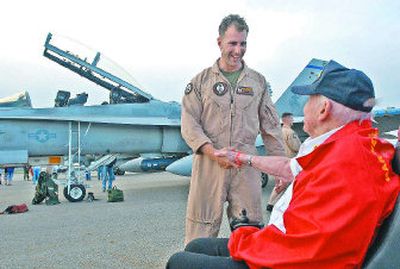Pilots share common ground

Just before sunset Friday, an old Marine pilot sat in his wheelchair on the tarmac of the Coeur d’Alene Airport staring up at the sky. Two fighter jets screamed past, dipping their wings in tribute to him.
Garth Haddock, who flew fighter planes for the Marines in the skies above the vast Pacific six decades ago, sat motionless. The 86-year-old Coeur d’Alene resident teared up as the planes did their graceful dance.
“I envy them,” he said.
When the F-18s landed, they glided to a stop nearby. Haddock rolled to the planes in his motorized chair. He was trailed by a small contingent of fellow Marines who helped him get to the airport from his assisted living home. Haddock was wearing his campaign ribbons and medals from the war, including the Distinguished Flying Cross.
The canopy opened on one of the jets. Capt. Kristian Larsen, a 1987 Coeur d’Alene High School graduate, climbed down from the cockpit and approached Haddock. Larsen shook his wrinkled hand, called him “sir” and was clearly in awe.
“A World War II pilot, right here,” Larsen said, gesturing at Haddock.
Larsen had flown here in part as a tribute to Haddock, who flew Corsair F4U fighter planes in the Black Sheep Squadron during World War II. While visiting family over Christmas, Larsen had read about Haddock in a Spokesman-Review story. He paid him a visit and decided to give his fellow Marine aviator a special tribute with his fighter jet flyover Friday.
Without the work of Haddock and his fellow veterans, “Nothing that we have today would be possible,” Larsen said.
The flight was mostly for training, said Larsen, who is based at the Marine Corps’ Air Station Miramar in California. He and another F-18 pilot flew their aircraft on a training mission Friday but were given special permission to end their day in Coeur d’Alene and spend the night.
Haddock had been notified in advance to be at the airport for a special show, said his friend and fellow Marine Corps League Pappy Boyington Detachment member Bob Rohrscheib, who landed with the Marines at Iwo Jima.
“He looked forward to this all day,” Rohrscheib said. “He was antsy all day.”
Rohrscheib, Haddock and a few other leathernecks told war stories on the tarmac as they waited for the fighter jets to arrive. Rohrscheib, a self-described ground-pounder, chided the aviator for having it relatively easy. But he wasn’t disrespecting the work the pilots did.
“There’s nothing like air support,” Rohrscheib said.
Haddock said the missions over the Pacific and Okinawa were long and tough. The Corsair was a fast, powerful plane, but it wasn’t always easy to control. Still, he said he’d give almost anything to be sitting in a pilot’s seat these days.
“It’s hell to be sitting in one of these things,” Haddock said, referring to his wheelchair.
But his spirits soared after the F-18s appeared. His eyes were bright, and he smiled while trading flight stories with Larsen.
While they were talking, Larsen reached into his flight suit and pulled out a coin with his unit designation, Marine Fighter Attack Squadron 225, the Vikings. He gave the coin to Haddock.
“It’s a tradition among fighter pilots,” he explained.
Larsen will fly out of Coeur d’Alene today. This summer he leaves for Iraq. It will be his fifth deployment there in five years. In Iraq, he flies air support for the Marines on the ground – troops he refers to as “the real fighters.”
Sixty-three years ago, Garth Haddock was doing the same thing.